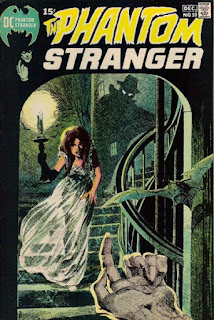Detective Comics #405 (On Sale: September 29, 1970) has another moody Batman cover by Neal Adams.
We begin with Batman in "The First of the Assassins!" by Denny O'Neil, Bob Brown and Frank Giacoia. Answering the Bat-Signal, Batman is informed by Commissioner Gordon that a number of murders that have taken place in Europe and, according to information by the Interpol, the next target is a shipping magnate, K.C. Agonistes, whose boat is currently in Gotham Harbor. Since the man has refused police protection, Gordon is tied and can't do anything officially and hopes that Batman can act unofficially on his behalf.
That night, Batman infiltrates the ship, but is immediately detected by extra security measures incorporated into the ship. The magnate, his fiancée, and his employees greet Batman with pleasure and they welcome him to be part of their journey. After taking a closer look at other security measures on the ship, Batman starts patrolling the deck at night. When Batman notices a disturbance in the waters, he tells the crew to evacuate the ship in the lifeboats. Batman then being shooting at at a pod of dolphins, but he is unable to prevent the destruction of the ship as one of the animals carrying a plastic explosive gets past his onslaught..
Batman reaches the only lifeboat that made it free in time where he joins a sailor, Agonistes and his fiancée. They sail to a nearby island, which seems abandoned at first sight, but they swoon realize is littered with boobytraps. After saving the three people from lethal traps, Batman goes into the island to find the killer. Shortly after, Batman realizes that he has been lured away from his companions and he rushes back, but falls for a trap in the midst of the jungle. From the shadows comes a nimble man, the same responsible for trying to kill the magnate. The man tells Batman that he has a mission to accomplish and that after he's finished, he will come back to kill him as well.
Batman breaks free from the trap and he heads to the camping site where Agonistes and the others are waiting for his return. He arrives in time to prevent the assassin from killing them and a fight ensues. The assassin reveals that he is part of a larger faction known as the League of Assassins, which cannot be bribed or stopped. The killer gets the upper hand in the fight and he gets ready to eliminate Batman, when he is suddenly blinded by some flares that explode on Batman's cape, which was burning in the fire. Batman takes the chance to defeat the assassin, but he knows that he is just a pawn in a larger scheme, orchestrated by a master criminal mind. This story was reprinted in Showcase Presents: Batman Vol. 5 TPB.
Next is Batgirl in "The Living Statue" by Frank Robbins, Gil Kane and Frank Giacoia. Continuing from last issue, Batgirl has been investigating the murder of X-rated film director Billy Warlock, whom her friend, Jason Bard, has been framed for. Her search brought her to Warlock's studio where she was captured by one of Warlock's actresses Veda who masterminded the whole scheme and is now preparing to trap Batgirl in plaster.
As she slowly covers Batgirl in the plaster, she destroys the evidence that would clear Bard's name while boasting to Batgirl that she got away with murder. To added rich irony she screams this at a giant lit up face of Warlock that was set in the studio. As the fire from the burning evidence spreads, Veda prepares to apply the last of the plaster that will cover Batgirl's head when another of Warlock's actresses: Infra-Red charges in the room to stop Veda.
While the two girls fight, Batgirl gets free and eventually has to save them from the flames. After when the fire department shows up, Veda boasts how they'll never be able to prove that she murdered Billy Warlock, but then Infra-Red informs her that in the giant portrait of Billy's face was a camera that filmed her whole confession. With it turned over as evidence, --as Barbara Gordon -- Batgirl gets to witness Bard being cleared of all charges and set free. This story has been reprinted in Showcase Presents: Batgirl Vol. 1 TPB and Batgirl: The Bronze Age Omnibus Vol. 1 HC.
We end with a filler reprint, "The Sleuth in the Iron Mask" drawn by Bob Brown and reprinted from Gangbusters #62 (1958).
Edited by Julius Schwartz.



























